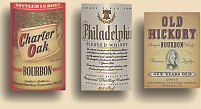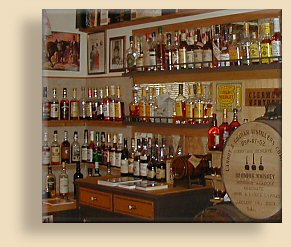American Whiskey
Distilleries of Eastern
Pennsylvania
June 16, 2006
|
|
"OH, PUBLICKER? Y'mean dah one down in Sowt Philly?
Yeh, I remember it.
'At was the whiskey distillery that made the Superfund Hazardous
Materials list"
"Yo! I sure whun'tah wanted ta drink any o' THAT whiskey!!"
Heh-heh! Yuck-yuck!
Wrong, CheeseSteak-breath.
Y'see, you're just used to the idea that someone operating a distillery is only
doing that in order to make beverage alcohol. But that's not always so.
Publicker's main business was as an industrial chemical plant.
A very large industrial chemical plant.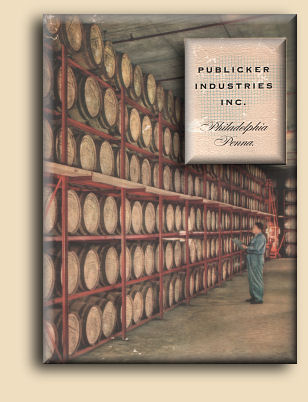
And even though they made a LOT of whiskey, that was only a small part of their operation. The whiskey-making part, Continental Distilling, folded up in the early '80s along with the rest of the company, but that didn't have anything to do with the hazardous conditions at the South Philadelphia alcohol refinery. Actually, Continental is still around, but it's an industrial distillery and food processing equipment dealer now. Publicker is still around, too, although they changed their name to PubliCARD in 1998 and went into the smartcard business. Apparently they're not doing so hot with that, either. According to their own investor relations page they don't expect to be around past the third quarter of 2006. And, at 3.5 cents a share, they don't expect there to be any funds remaining to distribute to shareholders. either. Which is pretty much what they tried to do to Philadelphia twenty years ago...

In June of 1987 a five-alarm fire broke out at a former Philadelphia chemical
plant. It wasn't the first time. It wasn't even the worst fire that site had
experienced.
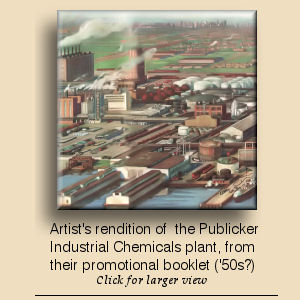 But it was bad enough to have presented a threat of hazardous
wastes and dangerous materials that brought it to the attention of the Federal
Environment Protection Agency. And over the next ten years the former home of
the Publicker Industrial Chemical Company, now identified as CERCLA (superfund)
site #0303196, became known as one of the worst cleanups in the history of the
EPA (and PADER, the Pennsylvania Department of Environment Resources).
But it was bad enough to have presented a threat of hazardous
wastes and dangerous materials that brought it to the attention of the Federal
Environment Protection Agency. And over the next ten years the former home of
the Publicker Industrial Chemical Company, now identified as CERCLA (superfund)
site #0303196, became known as one of the worst cleanups in the history of the
EPA (and PADER, the Pennsylvania Department of Environment Resources).
Publicker Industries, Inc., whose offices were (and still are) in West
Greenwich, Connecticut, began with Mr. Harry Publicker, who started off steaming
old whiskey barrels and extracting from them the gallon or two of whiskey that
had soaked into the charred wood. This he sold, and when the government tried to
prosecute him for not paying the revenue tax on the whiskey, he became highly
indignant. Obviously the tax had already been paid — it was paid by the man who
let the whiskey soak into the barrel. Anyway, that is how Harry Publicker passed
from the barrel business to the alcohol business. In 1912 he built and operated
a distillery on the Philadelphia riverfront between Bigler Street and Packer
Avenue. His company produced whiskey and industrial alcohol products there until
1985.
During prohibition Publicker concentrated on producing non-beverage alcohol and
industrial chemicals, and became very successful. How successful, you ask? Well,
in the early '20s Publicker was fermenting and distilling potatoes, molasses,
corn, and various grains into some six million gallons of industrial alcohol a
year.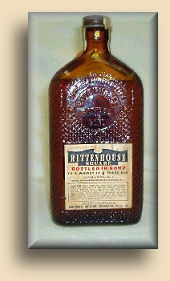 The company increased its capacity to sixty million gallons a year before
federal regulations tightened the industry allocation to a total of 70.5 million
gallons at the end of prohibition, of which Publicker produced a whopping 17 per
cent. By the mid-1950s the 40-acre plant at Packer and Delaware Avenue (which is now
called Christopher Columbus Blvd) had developed into one of the largest distilleries in the
world, specializing in products such as solvents, cleansers, antifreeze,
denatured alcohols, butyl acetate, ethyl acetate, acetone, dry ice and liquid
carbon dioxide, proprietary solvents, and refined fusel oil, among others. Not
to mention tons of high-quality livestock feed produced from the nutrient-rich
waste materials. The physical complex was comprised of twenty separate
buildings, 35 huge storage tanks, over 400 railroad cars and tankers. It was
serviced by the Pennsylvania, Baltimore & Ohio, and Reading railroads. Through
their subsidiary company, PACO, they operated a fleet of ten large ocean-going
tanker ships.
The company increased its capacity to sixty million gallons a year before
federal regulations tightened the industry allocation to a total of 70.5 million
gallons at the end of prohibition, of which Publicker produced a whopping 17 per
cent. By the mid-1950s the 40-acre plant at Packer and Delaware Avenue (which is now
called Christopher Columbus Blvd) had developed into one of the largest distilleries in the
world, specializing in products such as solvents, cleansers, antifreeze,
denatured alcohols, butyl acetate, ethyl acetate, acetone, dry ice and liquid
carbon dioxide, proprietary solvents, and refined fusel oil, among others. Not
to mention tons of high-quality livestock feed produced from the nutrient-rich
waste materials. The physical complex was comprised of twenty separate
buildings, 35 huge storage tanks, over 400 railroad cars and tankers. It was
serviced by the Pennsylvania, Baltimore & Ohio, and Reading railroads. Through
their subsidiary company, PACO, they operated a fleet of ten large ocean-going
tanker ships.
And after prohibition was repealed it was only natural for them to apply that
leverage of scale and their modern technologies to the production of potable
spirits.
 In August of 1933 they formed a subsidiary company, Continental
Distilling Corporation, and spent what would be over $27 million 2006 dollars
today to remodel their smaller distillery a few blocks north at the corner of
Snyder Street and Swanson Avenue. They filed the trademark on November 22, 1933
for their first brand, Charter Oak, which they registered for use with bourbon,
rye, rum, gin, brandy, and cordials. The Continental plant was especially
well-suited for producing blended whiskey and other spirit liquors, although
straight whiskey may have also been made there. They also produced gin and rum.
Some of their "manufactured" brands were Philadelphia, Diplomat, Cobb's Creek,
and Embassy Club whiskeys. Other early Continental brands were Haller's,
Linfield, and Old Hickory bourbons, as well as Rittenhouse and
Keystone State rye whiskeys. These were premium, aged whiskeys which may have been produced at
their more conventional distillery, Kinsey, about 35 miles up the Schuylkill
River in Linfield.
In August of 1933 they formed a subsidiary company, Continental
Distilling Corporation, and spent what would be over $27 million 2006 dollars
today to remodel their smaller distillery a few blocks north at the corner of
Snyder Street and Swanson Avenue. They filed the trademark on November 22, 1933
for their first brand, Charter Oak, which they registered for use with bourbon,
rye, rum, gin, brandy, and cordials. The Continental plant was especially
well-suited for producing blended whiskey and other spirit liquors, although
straight whiskey may have also been made there. They also produced gin and rum.
Some of their "manufactured" brands were Philadelphia, Diplomat, Cobb's Creek,
and Embassy Club whiskeys. Other early Continental brands were Haller's,
Linfield, and Old Hickory bourbons, as well as Rittenhouse and
Keystone State rye whiskeys. These were premium, aged whiskeys which may have been produced at
their more conventional distillery, Kinsey, about 35 miles up the Schuylkill
River in Linfield. However,
Publicker's own promotional description of that
facility -- also known as the Angelo Myers Distillery before prohibition -- focuses
entirely on the modern warehousing available there and proudly offers that its
fine whiskeys are aged there. But it only talks about aging. The promotional material never mentions
a word about distilling whiskey there
at all.
However,
Publicker's own promotional description of that
facility -- also known as the Angelo Myers Distillery before prohibition -- focuses
entirely on the modern warehousing available there and proudly offers that its
fine whiskeys are aged there. But it only talks about aging. The promotional material never mentions
a word about distilling whiskey there
at all.
Their success was probably at least partially due to a production technique that
their chemist, Dr. Carl Haner, developed. The way it was explained to a writer
for Fortune Magazine in 1934 is that, as every gentleman of the Old South knows,
if you put a keg of moonshine in the river it will age faster. Reason:
agitation. And if you put it near the stove it will age faster. Reason: heat.
Dr. Haner claimed to have devised a method of producing seventeen-year-old
whiskey in twenty-four hours. The Fortune writer thought that was a unique and
brilliant idea. Well, it may be brilliant, but it was hardly unique. That's the
same way most Maryland-style (and east Pennsylvania-style) whiskey was made
before prohibition, so it's hardly surprising that someone would revive the
method afterward. Of course, during the first few years after the end of
prohibition, when there was virtually no aged whiskey available, that would have
provided a very strong advantage.
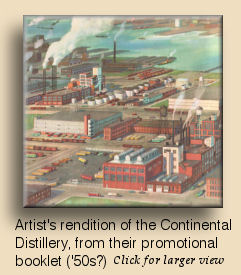 It was probably phased out as existing stocks
aged conventionally. By the forties, Publicker was most likely using those
techniques only with blended whiskey, as is still being done today.
It was probably phased out as existing stocks
aged conventionally. By the forties, Publicker was most likely using those
techniques only with blended whiskey, as is still being done today.
They were also making bulk and made-to-order whiskey for other companies, and
providing bottling services (essentially the same thing) for others. Our friend,
and amateur authority on western Pennsylvania distilling, Sam Komlenic is
convinced that Publicker had close ties with the East Penn Distillery which,
despite its name, was located in the 23rd District of Pennsylvania -- that would
be Pittsburgh and Monongahela. During prohibition, American Medicinal Spirits
used East Penn product to fill bottles they labeled and sold as Spring Garden (Maryland) Rye and I.W. Harper (Kentucky) Bourbon.
 Labeling required by the federally bonded
warehouses during that time made it necessary to state the true origins of
liquor on the back label, but as soon as prohibition ended and it was no longer
necessary to conform to bottled-in-bond regulations, many brands were bottled
tax-paid and that information
was no longer made available.
Sam also has documents indicating connections
between Publicker/Continental and other western Pennsylvania distilleries.
Labeling required by the federally bonded
warehouses during that time made it necessary to state the true origins of
liquor on the back label, but as soon as prohibition ended and it was no longer
necessary to conform to bottled-in-bond regulations, many brands were bottled
tax-paid and that information
was no longer made available.
Sam also has documents indicating connections
between Publicker/Continental and other western Pennsylvania distilleries.
And we have the Penn Esquire label shown here that clearly shows their working relationship with
the Pennco distillery of Schaefferstown (#17), a distillery most people would
better recognize as Michter's.
They were probably also the suppliers of rye whiskey to Merle's Standard Distillers
in Baltimore, for bottling Pikesville "Maryland-Style" Rye after their regular
provider, Majestic Distilling in Lansdown, Maryland, ceased production in the
early seventies. Heaven Hill, the Bardstown, Kentucky company that purchased the
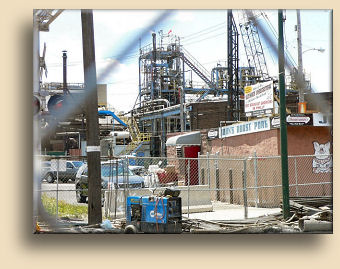 Pikesville brand in the early eighties also bought the Rittenhouse brand at
around the same time -- and they bought it from Publicker/Continental.
Pikesville brand in the early eighties also bought the Rittenhouse brand at
around the same time -- and they bought it from Publicker/Continental.
In June 2006 we visited the area where the Continental Distilling Corporation
once stood, where Weccacoe and Swanson Streets meet Snyder AvenueOf course it's not there anymore.
Or at least most of it. In fact, the buildings that
replaced it are in the process of being torn down themselves. There are remnants
of industrial distillery/refinery equipment that MIGHT have been part of a plant operating
less than thirty years ago. The most likely examples are now part of a plant
operated by Inolex. We took some photos of what's around here now.
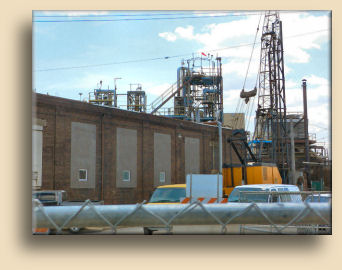 We were
standing in the Wal-Mart parking lot; if Inolex isn't the location it's entirely
possible that the Wal-Mart was it.
We were
standing in the Wal-Mart parking lot; if Inolex isn't the location it's entirely
possible that the Wal-Mart was it.
As you might guess, there is absolutely nothing to photograph at the site of the industrial chemical plant. The area itself has been stripped to the ground (and below) and is now being used to store countless stacks of... something. We can't get close enough to determine what.
A lot more interesting (at least to John, who
actually remembers when this ship sailed the ocean) is the SS United States moored to a pier just
north of the site. In the days when
 John was making model airplanes and ships
(and reading "A Night To Remember" as required for school) "The Big U"
held the record as
the fastest ocean liner in the world, and America's most luxurious. It was the Concorde
of its day, and Presidents
and Queens and Premiers and Movie Stars and such sailed aboard her. Maybe even
Jackie Kennedy! And here she
is, tied up to Pier 82, faded and rusty but still sharp-looking. The current
owners are hoping to scare up enough money to bring her back to service as a
cruise ship.
John was making model airplanes and ships
(and reading "A Night To Remember" as required for school) "The Big U"
held the record as
the fastest ocean liner in the world, and America's most luxurious. It was the Concorde
of its day, and Presidents
and Queens and Premiers and Movie Stars and such sailed aboard her. Maybe even
Jackie Kennedy! And here she
is, tied up to Pier 82, faded and rusty but still sharp-looking. The current
owners are hoping to scare up enough money to bring her back to service as a
cruise ship.
I sure hope they can.
She was a fine old ship, and I'd hate to see her just fade slowly away, until
some kind of dramatic
emergency causes her to be rendered into salvage.
Perhaps even hazardous salvage.
There used to be a distillery like that around here. Used to be right over there...

BUT ALL THAT LIQUOR wasn't really the main focus of Publicker Industries.
It was only a contributing factor. The company's real success was the industrial
chemical plant down by the Walt Whitman bridge. Production there peaked during
World War II and when they became a publicly-traded corporation in 1946 they
were employing over 5,000 people worldwide. And then in the early 1950s
something went terribly wrong. Publicker began a remarkable decline that spanned
four decades. In 1986, the company, now consisting of less than 300 employees,
ceased operations and sold the property to the Overland Corporation, a wrecking
company, for about the price of a small motel.
In the late '70s Publicker began making some of its huge tanks, which were
standing empty and idle, available to other companies for storing fuel oils. They added other processing that they performed under contract for various
chemical and fuel companies. One gets the impression that they might not always
have obtained licensing for these deals; it's possible they were less careful
about environmental impact studies than they might have been.
They added other processing that they performed under contract for various
chemical and fuel companies. One gets the impression that they might not always
have obtained licensing for these deals; it's possible they were less careful
about environmental impact studies than they might have been.
And then...
In June 1981 Pennsylvania Department of Environmental Resources (PADER) conducted a hazardous waste inspection and began issuing Notices of Violation.
Publicker Industries was requested to develop a Preparedness, Prevention and Contingency (PPL) Plan.In January 1983, another hazardous waste inspection was done by PADER, and issued notices of violation for lack of records for quantity, description, and disposition of solid wastes, and improper disposal of laboratory wastes. PADER also classifies the facility as a small quantity generator.
In October 1985 PADER conducted another hazardous waste inspection and issued notice of violation for storage of more than 100 30 and 55 gallon drums with unknown contents, and a leaking 20,000 gallon tank, contents also unknown. Off-specification alcohol incineration was also stopped and notification of waste transport and disposal was required.
PADER also conducted a water quality management inspection which resulted in notices of violation for various spills, including heavy oil and antifreeze or dye.In March 1986 Dames & Moore, an environmental consulting firm, began a preliminary environmental evaluation of the Site for the Cuyahoga Wrecking Corporation, the parent of Overland Corporation.
In June 1986 the United States Environmental Protection Agency (EPA) filed a complaint against Publicker Industries for operating a hazardous waste facility at the Site without a permit; storing ignitable waste on-site from June 9, 1983 to October 31, 1985; and shipping hazardous waste to Allied Petroleum in Norfolk, Virginia In October 1985.
In July 1986 PADER conducted yet another hazardous waste inspection and issued a further notice of violation for on-site storage of drums, many of which were corroded and leaking, and PCB oils in building transformers.
Publicker contended that they contracted Cuyahoga to remove the drums in question.In October 1986, PADER obtained a judgment requiring Overland Corporation and Cuyahoga Wrecking Corporation to submit a proposal for removal and disposal of wastes.
In November 1986, two Cuyahoga Wrecking Corporation demolition workers were killed during an explosion while cutting a pipeline containing residual ignitable material.
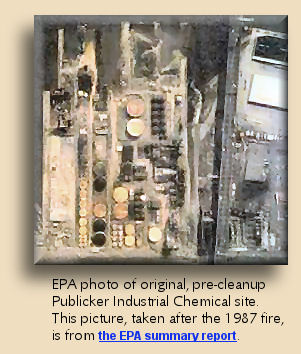 Shortly thereafter, Overland Corporation and Cuyahoga Wrecking Corporation
declared bankruptcy and abandoned the site.
Shortly thereafter, Overland Corporation and Cuyahoga Wrecking Corporation
declared bankruptcy and abandoned the site.
In June 1987 PADER conducted a preliminary assessment of the site, discovering large amounts of asbestos from pipe insulation, and large amounts of solids, sludges, and liquids of unknown types in rail tank cars, tank trucks, and storage vessels.
And then there was the fire mentioned earlier. Destroying the carbon dioxide utilization area and one of the piers, it burned for two hours, during which muffled explosions and fire flares were observed. Federal EPA officials don't like fire flares. They particularly don't like muffled explosions.In July 1987 the Federal EPA conducted their own inspection, finding numerous spill areas, improper drum storage,
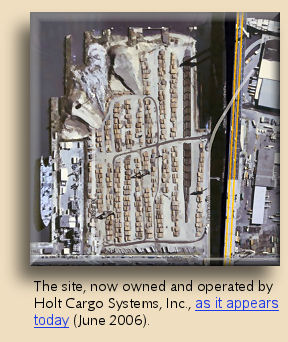 a leaking process line, an
oily sheen emanating from the site into the Delaware River, and shock sensitive
and explosive materials throughout.
a leaking process line, an
oily sheen emanating from the site into the Delaware River, and shock sensitive
and explosive materials throughout.
The NPL Site Narrative Report cites over 400 tanks, rail cars, and tank cars holding approximately two million gallons of hazardous materials; approximately 1,200 drums; four chemical laboratories with an estimated 7,000 containers of known content (including acids, explosive compounds, and flammable compounds) and 5,000 containers of unknown content; 180 cylinders holding toxic, flammable, and reactive gases; 150 pieces of electrical equipment, some containing PCBs; several hundred miles of aboveground and underground transfer lines, some covered with asbestos; reaction vessels; production buildings; and two power houses. In addition, they that most of the vessels and transfer lines apparently held hazardous materials and were either actively leaking or in disrepair due to neglect or vandalism.
Other than that, though, the place appeared to be just fine...In September 1987 EPA filed a consent agreement and order under Section 106 CERCLA against Publicker Industries, Inc.. Under the order, Publicker Industries agreed to hire an outside firm to perform a Site assessment.
In December 1987 EPA conducted another site inspection and declared the site a threat to human health and the environment.
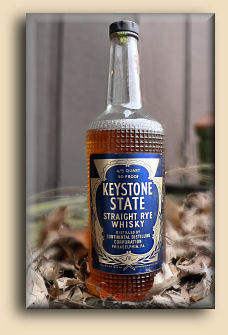 Cleanup was
begun immediately, using CERCLA emergency funds, and continued for a full year.
Cleanup was
begun immediately, using CERCLA emergency funds, and continued for a full year.
However, a detailed Site Inspection by PADER taken during the summer of 1988 showed that the soil and groundwater were also hopelessly contaminated.In May 1989 the site scored a 59.99 on the EPA's Hazard Ranking scale, which earned it the honor of a place on the Hazardous Site National Priority List (NPL).
The cleanup and inspections and further cleanup, etc. continued until the site was finally pronounced completed and removed from the Superfund National Priorities List of most hazardous toxic waste sites. That was in November 2000, fourteen years and around twenty million dollars after Publicker Industries, Inc. had already washed their hands of the alcohol-distilling business and left Philadelphia to wallow in its wake.
And for more -- MUCH more -- about the
Publicker/Continental distillery...
Dave Ziegler, a fine gentleman who worked for many years at Publicker's Kinsey
facility in Linfield, has become an amateur historian and one-man museum of lore
and memorabilia from these distilleries. As a frequent contributor to
www.bourbonenthusiast.com and
other sites, Dave provides an overwhelming wealth of detail and reminiscences
that will make you feel as if you'd worked there all your own life, too. We
had the unique and very enjoyable pleasure of spending part of an afternoon with
Dave in the summer of 2009.
And now (as of 2015) one of
Publicker/Continental's key brands of whiskey
is once again available and being made in Philadelphia
See our page on the Millstone Spirits Group and the
New Liberty distillery!

